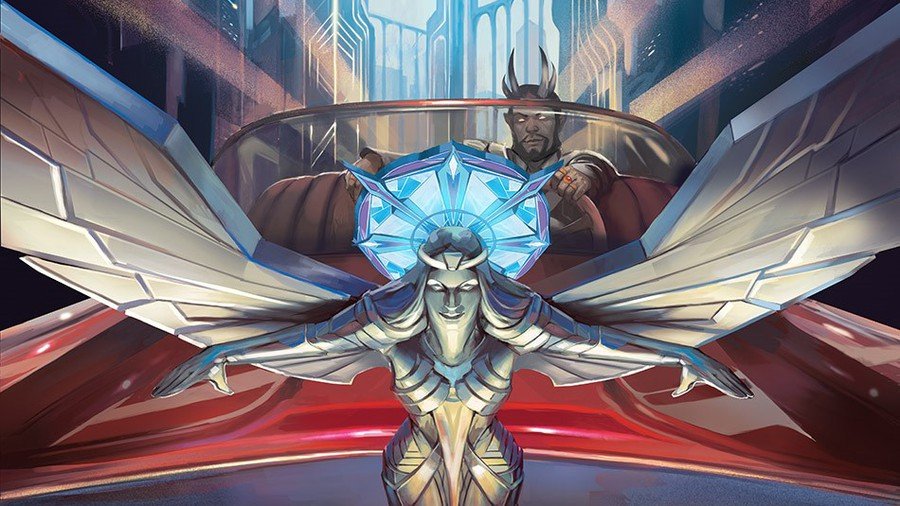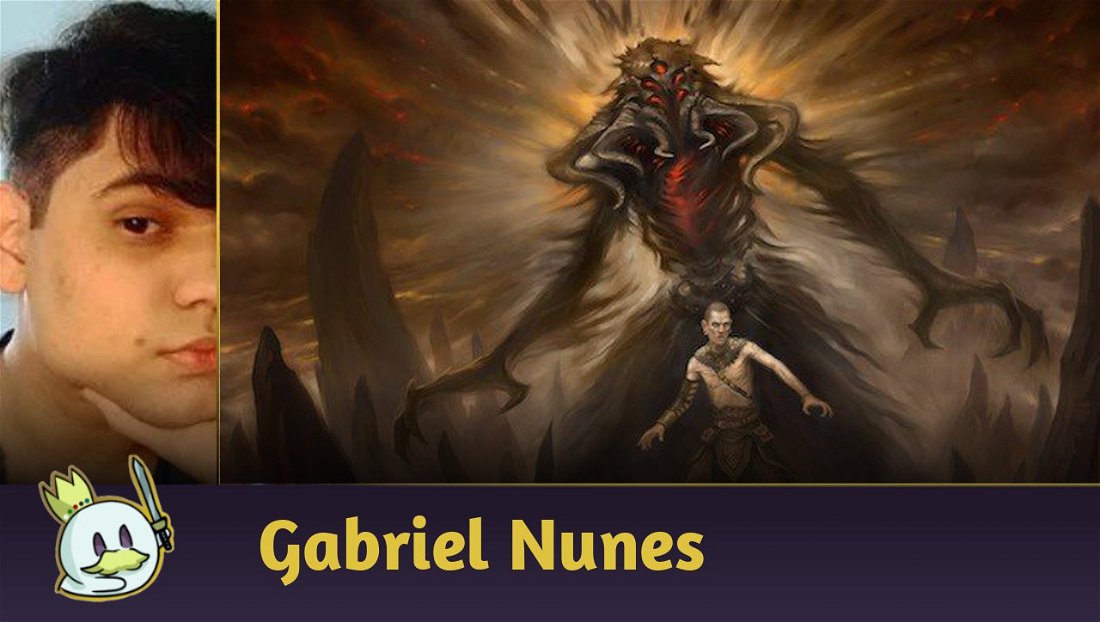Introduction
The announcement of the Crime Lords of Streets of New Capenna caused quite a stir among players of all formats, even more so for Commander players. Lord Xander, the Collector is one of these lords of the underworld and his color identity is Maestros (aka Grixis), and his abilities represent the same three forces as the corresponding Alara shard: discard, mill, and sacrifices.
Its extravagant cost is challenging, almost an invitation to all sorts of subterfuge - since, once in the game, it allows interactions that drastically unbalance the game. We chose to play similarly to Cruel Control, playing in a reactive way, exhausting resources at the beginning of the game and playing threats as we develop our board in moments in which tapping the lands on our turn no longer causes bigger problems and value cards are decisive for the end of the game.
Starting Ideas
Lord Xander on turn 1
When I envisioned the possibilities with Lord Xander, the Collector, I focused on solving the problem “it's seven mana of which one blue, one red and one black” and soon came to the simple solution: Command Beacon. Having this land in the starting hand or efficient tutors, it is possible to solve this problem in the first turns of the game. However, in a High Performance, or High Level match, it occurred to me: Lord Xander, the Collector in the first turn.

Soon we started talking about that peculiar game and realizing that there are more and more ways to do this, just putting the commander into hand, and a hand with Netherborn Altar + positive mana rocks, and could mean a possible turn 2 Xander with Faithless Looting and Reanimate.
He didn't immediately win matches, but he made things very difficult. The more refined and optimized the deck, the faster and more tedious the game became. After all, we didn't want a competitive match, we just wanted to have fun on the weekend. From this new motivation, the list that we will see below was born.
The Friendly List
To scale the power and efficiency of your decks of different formats, use the power level calculator — the following list has had its power adjusted to a 7 power level.
The Commander

The short story “Homecoming” by Elise Kova, is the first chapter of the New Capenna lore, and describes Lord Xander as an avid and refined fashionista. It immediately reminded me of the character of David Bowie in The Hunger, a film also starring Catherine Deneuve and Susan Sarandon, where we have elegant and modern vampires.
Following trends through the centuries, we have the information that Lord Xander, the Collector has lived since before the city was founded. Residing in his luxurious retreat with a privileged view of the city, atop one of New Capenna's imposing buildings, he bears the marks of a life of violence and murder. His quarters contain a collection of ancient relics. A museum of the history of New Capenna, the remaining artifacts of a time he no longer remembers due to the distortions of time and eternities.

In the game, Lord Xander, the Collector inspires fear with his abilities triggered at different times in the game. When it enters the battlefield, the opponent discards half of the cards in their hand — black discard effects are often linked to a history of insanity, or as in New Capenna's case, Coercion and Blackmail .
Its second ability triggers when attacking and mills half of the defending opponent's library — the mill mechanic is tied to memory loss, misinformation, and in the set's context to trauma and violence, such as Grisly Spectacle and Extractor Demon.
Its last ability triggers on death, when resolved target opponent destroys half of their nonland permanents — the few cards we have in black with this effect are linked to tragedies of great proportions.
The Strategy
Our deck was built with the goal of being played like a controller, using opponents' cards to gain advantage in early turns through reversals and copying spells as forms of disruption.
We also have creatures that generate value, either through draws or thief elements, capturing threats from opponents to develop our board. Diverse tutors to select answers or proactive elements to lead us to victory.
Reanimations are an important part of interactions with our commander, taking advantage of his abilities. The use of alternate methods of entering the battlefield was maintained using Command Beacon and Netherborn Altar allied to Purphoros, Bronze-blooded and Strefan, Maurer Progenitor.
Mana Base
The Lands
The manabase has a total of 34 lands using a mix of taplands and utility lands, whether they are mana filters or lands capable of generating all the colors of the commander's identity.
Within our strategy, Command Beacon is essential and Tolaria West has been included to tutor it, rather than the ever-helpful Ash Barrens. Some fetchlands from Mirage were chosen because they allow picking up two-colored lands to correct the curve.
Storage lands allow us to take advantage of excess mana in turns that we don't use answers and speed up more important high-cost spells. Defining the amount of land is always a delicate subject, so Cards Realm has developed a application to assist in this task.

Accelerators
We used a total of 12 accelerator pieces between mana rocks, rituals and land tutors. Burnt Offering is excellent as we have access to red combined with creatures reanimated or summoned by the opponent generates a significant amount of mana.
Using opponents' ramp spells is always a good target for Split Decision or copy spells. Reanimating targets like Burnished Hart or Solemn Simulacrum can generate funny situations and extra mana. Tergrid, God of Fright, Fiend of the Shadows and Kheru Mind-Eater can also be used to play lands.

Card Advantage
Our options for cards for purchase are varied between card selection, tutors, purchases and others, totaling more than 20 cards capable of generating some advantage.
Let's group the cards according to their function. Land addition cards like Armillary Sphere and Gem of Becoming have already been mentioned along with accelerators. We can similarly see cards that add commander to our hand, such as Netherborn Altar and Command Beacon.
Draws
We chose cards capable of generating a lot of advantage with the development of the turns, maintaining our cadence of purchases. We looked to find options to replace Dark Confidant and Phyrexian Arena. While Phyrexian Etchings is one of my favorite options, the black mana upkeep cost was a point to consider since we played with three colors.
Eye of Vecna already stole two mana that was needed in a disruptive strategy. Gravelighter was an excellent addition, acting like Solemn Simulacrum and Mulldrifter by being reanimated over and over again.

An extra card every turn is a huge advantage and to keep it we count on Les Trois Mousquetaires, Mindblade Render, Azra Oddsmaker and Florian, Voldaren Scion drawing cards in each combat, and in our version of Alexandre Dumas' historical novel, we have a fourth character: Keen Duelist, our D'Artagnan.
Geth's Grimoire and Mask of Griselbrand have powerful interactions with our commander, generating a significant number of draws. Another fact to note is that Mask of Griselbrand guarantees an important evasion and lifelink.
Tutors
The group of tutors is composed of generic and specific tutors, the first ones being Beseech the Queen and Diabolic Tutor, the rest are the transmuters Clutch of the Undercity, Shred Memory and Tolaria West and the artifact and land tutor Moonsilver Key.

Thieves
A way to generate advantage and exhaust resource of our opponents is to take control of their permanents and play their spells.
Several creatures allow taking cards during combat, and we selected some of these robbers for our strategy. Kheru Mind-Eater, Fiend of the Shadows and Tergrid, God of Fright cards have powerful allies in Gonti, Lord of Luxury and Etali, Primal Storm, and allows you to play opponents' spells.
Another option is to utilize opponents' creatures with Zara, Renegade Recruiter and Rakshasa Debaser, which take control of creatures during combat, and Spawnbroker offers a friendly trade.

Recursions
The vast majority of our recursions are reanimations, meaning they return creatures from the graveyard to the battlefield.
Apprentice Necromancer and Feldon of the Third Path have a very fine synergy with our commander, as they allow us to use all of his abilities in a single turn.
Another interesting creature is Body Snatcher, which allows you to discard your commander from the hand and then reanimate it when paired with a sacrifice engine. Nezumi Graverobber often goes unnoticed by opponents, however, when it transforms, it's a powerful reanimation card — and its ability, although it has a high cost, is at instant speed and with no restrictions.

We used some spells to return creatures from the graveyard to the battlefield, these were chosen based on a quirk: requiring the sacrifice of a creature as part of its effects. Only two of them break the rule, which are Persist and Grim Discovery. The others allow interactions with the commander or have multiple targets, adding greater value.

Interactions
Interacting with opponents is vital in a control deck, and most of our interactions are proactive and our commander caters to all of them, allowing you to discard, mill, and/or sacrifice half of a player's permanents.
Having less room for disruptive interactions, much of the deck's operation resembles a tap-out. As mentioned before, we provide a small package of copies and redirects. Knowing this, we continue with the other categories.

Removals
In the large group of targeted removals, we have Noxious Gearhulk, able to deal with threats and gain life. Spawnbroker is fascinating, since it switches control from one creature to another, it always reminds me of Gilded Drake, due to the surprise it causes.
Mayhem Devil is a great removal given that our commander generates numerous sacrifices. On the other hand, Feed the Swarm is an important card since it deals with creatures and enchantments, as well as Clutch of the Undercity that returns a nonland permanent to the owner's hand. Makeshift Munitions is a spot removal and a sacrifice engine.

The sacrifice subgroup has Gravelighter in addition to Fleshbag Marauder, Barrin's Spite which puts the opponent in an interesting situation, where they must choose between two creatures and remove both from the battlefield.
Two of the biggest threats in our deck are sacrificial removals, Cruel Ultimatum and Curse of the Cabal. Both have the potential to eliminate one of the opponents in the game. However, the most interesting bomb is Curse of the Cabal, which can be suspended and put a lot of strain on opponents, as the player who gets hit sacrifices half of their permanents.

We have some sweepers, two of which are proactive: Pyroclasm, which deals with many creatures in the initial turns and Reduce to Dreams, a sweeper for enchantments and artifacts in blue. Another blue pseudo-sweeper is Aetherize, which returns all attacking creatures to their owners' hands.

Since we put many opponents' cards to the graveyard, whether through sacrifices, discards, or milling, we need to deal with the collateral effect to not generate an advantage for a specific deck.
Tergrid, God of Fright is the best in this regard, as we capture our opponents' cards. Nezumi Graverobber has an activated ability that removes cards from graveyards and, after transforming, plays creatures from the graveyard.
On the other hand, Syr Konrad, the Grim punishes opponents once again by dealing damage to each creature that goes into the graveyard, or even when they leave it, making the old knight synergistic with all our strategy. Shred Memory and Rakdos Charm are instants that get rid of a considerable number of cards from the graveyard.

Winconditions
Our primary wincondition is interactions with our commander. For this, we have strategies to circumvent his costs. The first and motivator of this article is the use of Command Beacon and Netherborn Altar to add our hand. So, we have the following options:
1. Play directly using card effects like Purphoros, Bronze-Blooded, Shifty Doppelganger and Strefan, Maurer Progenitor.
2. Discard via some effect like Desolate Lighthouse, for example, and reanimate it.
3. Discard it and create copies with Feldon of the Third Path.
Sacrifice and repeat.
We have several spells that cost a creature to sacrifice or even force a player to sacrifice. However, the best results have been with Greater Gargadon and occasionally with Curse of the Cabal.
Using Burnt Offering allows for very explosive turns playing the commander and then Cruel Ultimatum in a strong sequence. Another interesting iteration using Offering is combined with Nighteyes the Desecrator, sacrificing and reviving the commander in quick succession.
Conclusion
Lord Xander the Collector is one of the strongest Grixis commanders we have in Magic, his abilities are immense, and it's not difficult to get around his costs.
On the other hand, when used in a more casual way, it is a very fun bomb and there were no problems with it, and once again we ran into the issue of expectations regarding the game. We already had a recent article about this.
In games in higher power environments, he proves to be a good commander. I don't believe he will make it to cEDH, but that's not impossible, after all we have pretty consistent lists built around other huge creatures.
Possible Upgrades
The first suggestions are the use of cards that allow you to play the commander directly from the command zone, such as Hellkite Courser and Geode Golem, which are easily accessible and very efficient cards. We can also add Sneak Attack. To multiply the effects, good options are Lithoform Engine, Panharmonicon and Strionic Resonator.
I really like Choice of Damnations, which was only taken off the list to respect the budget. Gisa, Glorious Resurrector serves to generate more advantage with the commander's abilities, and in this same line we have It That Betrays and Dauthi Voidwalker. Bruvac the Grandiloquent is interesting, causing the player to mill the entire deck. We can also have blink lines with Deadeye Navigator and Fell Specter.
Going for the more optimized line, I recommend Sorin, Imperious Bloodlord and a well-accelerated manabase with positive mana rocks and rituals, as well as lootings and good tutors.
Thanks for reading and good games!
Any questions, I'm available in the comments!














— Comments 0
, Reactions 1
Be the first to comment